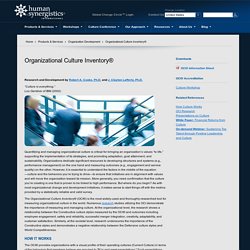

Organizational Culture Inventory - measuring organizational culture. Research and Development by Robert A.

Cooke, Ph.D. and J. Clayton Lafferty, Ph.D. “Culture is everything.” Lou Gerstner of IBM (2002) Quantifying and managing organizational culture is critical for bringing an organization’s values “to life,” supporting the implementation of its strategies, and promoting adaptation, goal attainment, and sustainability. The Organizational Culture Inventory® (OCI®) is the most widely-used and thoroughly-researched tool for measuring organizational culture in the world. How It Works The OCI® provides organizations with a visual profile of their operating cultures (Current Culture) in terms of the behaviors that members believe are required to "fit in and meet expectations. " Defining an Ideal Culture A special version of the OCI®, the OCI-Ideal, provides leaders and organizations with a tool for quantifying, envisioning, and communicating their ideal or preferred organizational culture.
Outcomes of Culture The OCI can be used for: Interested In Using The OCI? Oci product info sheet. Deal and Kennedy's Cultural Model - from MindTools.com. Understanding Rites and Rituals in Corporate Culture © iStockphotohatman12 Corporate culture is one of the key drivers for the success – or failure – of an organization.

A good, well-aligned culture can propel it to success. However, the wrong culture will stifle its ability to adapt to a fast-changing world. So, how do you attempt to understand your corporate culture? In their classic 1982 book, "Corporate Cultures: The Rites and Rituals of Corporate Life," Terrence Deal and Allan Kennedy proposed one of the first models of organizational culture. Deal and Kennedy's Cultural Framework In their work on the subject of culture, Deal and Kennedy suggested that the basis of corporate culture was an interlocking set of six cultural elements: History – A shared narrative of the past lays the foundation for corporate culture. Tip: When thinking about this, see also our article on Johnson and Scholes' Cultural Web , which was developed about 10 years later. Hofstede's Cultural Dimensions - From MindTools.com.
Understanding Different Countries © iStockphototakasuu Learn how to work with teams and co-workers from around the world.

Imagine this scenario: Sayid's boss has asked him to manage a large, global team. In this new role, he'll be working closely with people in several different countries. He's excited about the opportunities that his connectedness will present, but he's also nervous about making cross-cultural faux pas. He knows that cultural differences can act as a barrier to communication, and that they could affect his ability to build connections and motivate people. In this article, we'll explore how you can use Hofstede's Six Dimensions of Culture to work effectively with people from a range of cultural and geographic backgrounds.
Hofstede's Six Dimensions of Culture Psychologist Dr Geert Hofstede published his cultural dimensions model at the end of the 1970s, based on a decade of research. Hofstede studied people who worked for IBM in more than 50 countries. Tip: , intelligence 1. The Cultural Web - Strategy Tools from MindTools.com. © iStockphotoRidofranz Many aspects of organizations are interconnected.

What is the first thing that pops in your mind when you hear the term corporate culture? A great many people refer to the classic phrase coined by the McKinsey organization, that culture is "how we do things around here. " And while that may be true, there are so many elements that go into determining what you do and why, that this definition only scratches the surface. Whether you can define it or not, you know that culture exists. Culture often becomes the focus of attention during periods of organizational change – when companies merge and their cultures clash, for example, or when growth and other strategic change mean that the existing culture becomes inappropriate, and hinders rather than supports progress.
So, for all its elusiveness, corporate culture can have a huge impact on an organization's work environment and output. Elements of the Cultural Web From "Fundamentals of Strategy" by G. Using the Cultural Web. Handy's Four Types of Cultures - Team Management Training From MindTools.com. Choosing the Best Culture for Your Organization © iStockphotoninapuppe Organizations are similar to countries: they each have a unique culture based on values, beliefs and common expectations.

Each culture has its strengths and its weaknesses. Many organizations resist changing their culture once it's developed. But organizations grow and change over time, just like a living thing, and the culture must grow and change as well for it to succeed in the long term. The most successful organizations have the right culture in the place for what they're trying to do. In this article we'll look at Handy's Four Types of Culture, a model that describes four unique organizational cultures. About the Model Charles Handy, a management consultant and professor at the London Business School, developed the Four Types of Culture and published them in his 1978 book "Gods of Management. " Handy's theory describes four distinct management styles, each with its own values.
Access the Full Article. Borgatti knowing what we know.